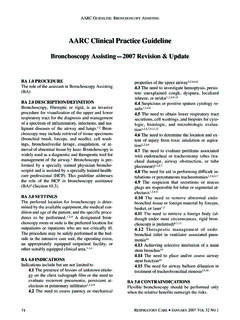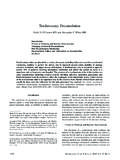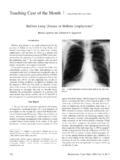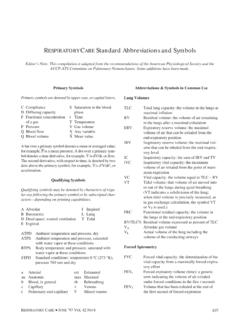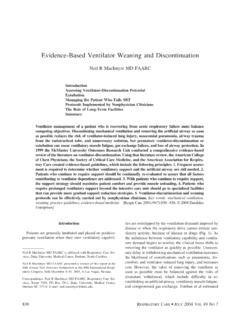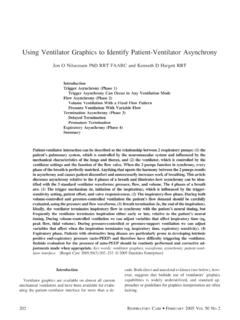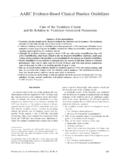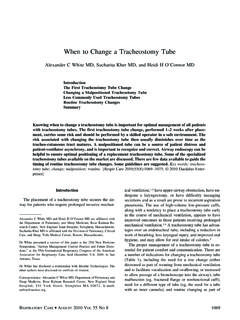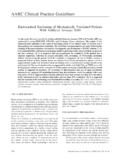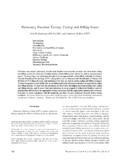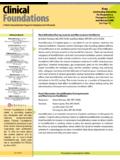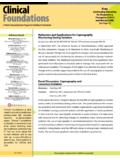Transcription of A Stepwise Approach to Management of Stable COPD With ...
1 A Stepwise Approach to Management of Stable COPDWith inhaled pharmacotherapy : A ReviewRuben D Restrepo MD RRT FAARCI ntroductionAvailable AgentsBronchodilatorsAnticholinergicsAdv erse Events of Anticholinergic Agents 2 Adrenergic AgentsAdverse Events of 2 Adrenergic AgentsInhaled CorticosteroidsEmerging PharmacotherapyPharmacoeconomicsStage-Gu ided Approach to inhaled PharmacotherapyMild copd (Stage I)Moderate copd (Stage II)Severe to Very Severe copd (Stages III and IV)DiscussionAlthough existing evidence confirms that no pharmacologic agent ameliorates the decline in the lungfunction or changes the prognosis of chronic obstructive pulmonary disease ( copd ), inhaled pharma-cotherapy is a critical component of the Management for patients suffering with copd . inhaled agentsare directed to provide immediate relief of symptoms and to restore functional capacity in treatment ofstable copd . While copd may not be cured, knowledge and implementation of currently availableguidelines provide the health-care provider alternatives to treat the disease effectively.
2 Respiratorytherapists play an important role in the implementation of these guidelines, since they are often respon-sible for educating patients on the correct use of the inhalers. This paper reviews current evidenceregarding the use of inhaled pharmacotherapy in the treatment of copd and provides a guided ap-proach to the use of different agents in Stable words: anticholinergics, adrenergics, copd ,chronic obstructive pulmonary disease, Global Initiative for Chronic Obstructive Lung Disease, GOLD,guidelines, inhalation pharmacotherapy .[Respir Care 2009;54(8):1058 1081. 2009 Daedalus Enterprises]IntroductionChronic obstructive pulmonary disease ( copd ) is a con-dition estimated to affect approximately 8% of the popu-lation and approximately 10% of individuals older than40 is expected to become the third leadingcause of death by Global Initiative for ChronicRuben D Restrepo MD RRT FAARC is affiliated with the Department ofRespiratory Care, The University of Texas Health Science Center at SanAntonio, San Antonio, Restrepo presented a version of this paper at the symposium copd :Empowering Respiratory Therapists to Make a Difference, at the 54th In-ternational Respiratory Congress of the American Association for Respira-tory Care, held December 13-16, 2008, in Anaheim, California.
3 Thesymposium was made possible by an unrestricted educational grant fromBoehringer author has disclosed no conflicts of : Ruben D Restrepo MD RRT FAARC. Department of Re-spiratory Care, The University of Texas Health Science Center at San AUGUST2009 VOL54 NO8 Obstructive Lung Disease (GOLD) evidence-based guide-lines for the treatment and Management of copd are theresult of collaborations of worldwide leading experts inCOPD and organizations that include the World HealthOrganization and the National Heart, Lung and Blood In-stitute. The staging system established by these guidelinesdefines severity of Stable copd according to airflow lim-itation, and also guides Management (Fig. 1).3 Addition-ally, other professional societies have published guidelinesfor the treatment and Management of the availability of these publications, health-care providers lack awareness and understanding of ,8 Respiratory therapists (RTs) are most of-ten the health-care providers responsible not only for ad-ministration of the available pharmacologic agents used inpatients who suffer from copd but also for the instructionon the different delivery devices.
4 It is critical that RTsacquire the necessary knowledge of the guidelines to op-timize treatment of their patients with copd . Awarenessand knowledge of a Stepwise Approach at times allow re-direction of therapy, when well communicated to the pri-mary-care physician ultimately responsible for patient smoking cessation is the most important inter-vention to manage copd , pharmacologic agents shouldbe added in a Stepwise fashion once the diagnosis of COPDis made. Optimizing bronchodilator therapy is probablythe most important pharmacologic Approach in stableCOPD; however, it is important to realize that to this date,no medication has been shown to conclusively alter thedecline in lung function that is the hallmark of copd orthe natural history of treatment does notalter the natural history of the disease, inhaled pharmaco-therapy for copd is used to prevent and decrease symp-toms (especially dyspnea), improve patients exercise tol-erance and health status, ameliorate disease progression,prevent and treat complications and exacerbations, andreduce the risk of death from growing inter-est in newer agents and their combinations, as well ascontroversial findings coming from recent meta-analysis,have emerged as the reasons why the last word on optimalpharmacotherapy for patients with copd is far from beingwritten.
5 This paper is an attempt to review the existingevidence to support the current Stepwise Approach to in-haled pharmacotherapy in the Management of patients withstable AgentsTwo different categories of inhaled agents are availablefor the Management of Stable copd : bronchodilators bronchodilators are the cornerstone of theinhaled pharmacotherapy for patients with copd . Theyinclude 2adrenergic agents and anticholinergics in theirshort-acting and long-acting formulations. Although sev-eral studies have failed to demonstrate improvement inlung function following a single dose, it is unquestionablethat bronchodilators have been shown to induce significantlong-term improvements in symptoms, exercise capacity,and airflow the staging of copd ,Fig. 1. Global Initiative for Chronic Obstructive Lung Disease recommendations for treatment at each stage of chronic obstructive pulmo-nary disease ( copd ). FEV1 forced expiratory volume in the first second. FVC forced vital capacity.
6 (From Reference 3, with permission.)STEPWISEMANAGEMENT OFSTABLECOPD WITHINHALEDPHARMACOTHERAPYRESPIRATORYCAR E AUGUST2009 VOL54 NO81059all symptomatic patients should be prescribed a short-act-ing bronchodilator to be used on an as-needed are inadequately controlled with short-actingbronchodilatortherapy,along- actingbronchodilatorshouldbe added to the regularly scheduled therapy. Althoughmost bronchodilators can be administered orally, subcuta-neously, or intravenously, inhalation is the recommendedroute of delivery. A nebulizer, metered-dose inhaler (MDI),or dry-powder inhaler (DPI) maximize the bronchodila-tor s direct effect on the airways, while minimizing sys-temic effects. Any of these devices, when used properly,achieve an equivalent bronchodilator all of the short-acting bronchodilators improvesymptoms and lung function, the question that the RT hasto answer when managing a patient with mild symptoms iswhich short-acting bronchodilator is the best. Short-acting 2adrenergic agents (SABAs) and short-acting anticho-linergics (SAACs) can be used alone or in SABAs have a rapid onset of action, combinationtherapy (SABA/SAAC) may be more effective in achiev-ing a bronchodilator response than either agent anticholinergic medications decrease broncho-constriction by reducing smooth muscle tone and glandu-lar ,17 Available anticholinergics, such as ipra-tropium and tiotropium, contain a quaternary ammoniumthat is responsible for the lack of penetration of the blood-brain barrier, lower systemic absorption, and a longer du-ration of action than their predecessor, the tertiary amine, ,19 Atropine and scopolamine are the most im-portant pharmacologically active and naturally occurringanticholinergic ,21In copd , bronchoconstric-tion and mucus secretion are caused mostly by increasedparasympathetic nerve activity, mediated by muscarinicreceptors.
7 Anticholinergic agents compete with acetylcho-line at these receptors on airway smooth muscle, decreas-ing the intracellular concentration of cyclic guanosinemonophosphate (cGMP) and inhibiting tonic ,23 There are at least 5 subtypes of muscarinic least 3 of these are expressed in the lung: M1 receptorsare present on peribronchial ganglion cells, where thepreganglionic nerves transmit to the postganglionic nerves;M2 receptors are present on the postganglionic nerves; andM3 receptors are present on smooth muscle. M1 and M3receptors mediate the parasympathetic bronchoconstrictiveeffect of the vagus nerve. The submucosal glands are alsoinnervated by parasympathetic neurons and have predom-inantly M3 receptors. The activation of M1 and M3receptors by acetylcholine and its analogs stimulates se-cretion by tracheobronchial glands and causes broncho-constriction. On the other hand, activation of M2 receptorslimits further production of acetylcholine and protectsagainst parasympathetic-mediated ,24An ideal anticholinergic agent would inhibit onlythe M1 and M3 receptors and spare the M2 available anticholinergic agents, however, in-hibit all 3 receptor ,24 Short-Acting the anticholin-ergic agents, ipratropium has probably been the most widelyadministered therapy for copd , alone or in (Atrovent, Boehringer Ingelheim, Ridgefield,Connecticut) is an anticholinergic bronchodilator that is asynthetic quaternary ammonium compound chemicallyrelated to is poorly absorbed intothe circulation from either the nasal mucosa or from theairway, and its half-life of elimination is about hoursafter inhalation ,25 Ipratropium is a non-selective antagonist of M1, M2, and M3 receptors.
8 Theblockade of the M2 receptor subtype allows further releaseof presynaptic acetylcholine and may antagonize the bron-chodilatory effect of blocking the M3 is available as a nebulizable solution concentration in a vial, and as a nasal sprayof and strength. Each actuation of the MDIdelivers 18 g of ipratropium from the mouthpiece. Incontrolled studies of patients with bronchospasm associ-ated with copd , ipratropium has been associated withsignificant improvements in pulmonary function within15 min. Its peak of action is reached in 1 2 hours andpersists for periods of 3 4 hours in the majority of pa-tients, both as monotherapy and as a combination withSABA, and up to 6 hours in some ,26,27 Therecommended doses of the MDI and the nebulizable so-lutions are 36 g 4 times a day, and mL vial (500 g)3 4 times a day, respectively. Although higher doses maybe required to obtain a maximal effect in patients withmore severe airway disease, tachyphylaxis to ipratropiumhas not been of ipratropiumwith albuterol are also available in MDI form, as Com-bivent (Boehringer Ingelheim), and in nebulizer form, asDuoNeb (Dey, Napa, California).
9 The use of these com-binations in Stable copd is described later in this has been shown to decrease dyspnea, in-crease exercise tolerance, and improve gas exchange inpatients with Stable , it does not haveanti-inflammatory properties and does not change the nat-ural history of copd or its ,30In a landmarkstudy, the Lung Health Study,9ipratropium was the bron-chodilator of choice in patients with copd , because ofits low frequency of adverse effects, relatively long dura-tion of action, and demonstrated bronchodilator , the investigators supported the use of broncho-dilators only for symptomatic benefit, including relief ofdyspnea and improvement in exercise OFSTABLECOPD WITHINHALEDPHARMACOTHERAPY1060 RESPIRATORYCARE AUGUST2009 VOL54 NO8pium has been shown to be at least similar to or betterthan SABA in relieving bronchospasm in patients withstable copd and at producing bronchodilation in patientswho lacked prior response to ,29,31 Several ran-domized controlled trials (RCTs) compared at least 4 weeksof treatment with ipratropium alone or in combination withSABAs in almost 4,000 patients with Stable ,32-39 Ipratropium showed a small benefit over SABAs on lung-function outcomes, improvement in health-related qualityof life (HRQL), and reduction in the requirement for significant changes in electrocardiographicand hemodynamic assessment were observed when com-bination therapy with SABAs was compared with SABA therapy alone over 85 days of both SAACs and SABAs are effective broncho-dilator agents, inhaled SAACs have been preferred by manyover SABAs in patients with Stable copd , because of itsminimal cardiac stimulatory effects and its greater effec-tiveness than is the only SAAC currently available for the Management of patients only inhaled long-acting anticholinergic (LAAC) currently available to man-age patients who suffer from copd is tiotropium.
10 Tiotro-pium is a second-generation quaternary ammoniumcompound introduced in the early 2000s, which is struc-turally related to ipratropium. Although most of the phar-macologic features and adverse effects are similar in allquaternary ammoniums, tiotropium differs from other an-ticholinergics in its functional relative selectivity and 20-fold higher affinity for muscarinic receptors when com-pared with tiotropium binds to all3 muscarinic receptors, it dissociates much faster from theM2 receptors, resulting in a more selective antagonist ac-tion for M1 and M3 muscarinic receptor ,44 Itsprolonged pharmacologic activity is the result of its slowdissociation from M1 and M3 receptors. The half-life ofthe tiotropium-M3 receptor complex is approximately35 hours, compared with hours for ipratropium(Fig. 2).18,42,44,45 Tiotropium is available as a DPI (Spiriva HandiHaler,Boehringer Ingelheim). The capsule contains 18 goftiotropium (equivalent to g of tiotropium).
